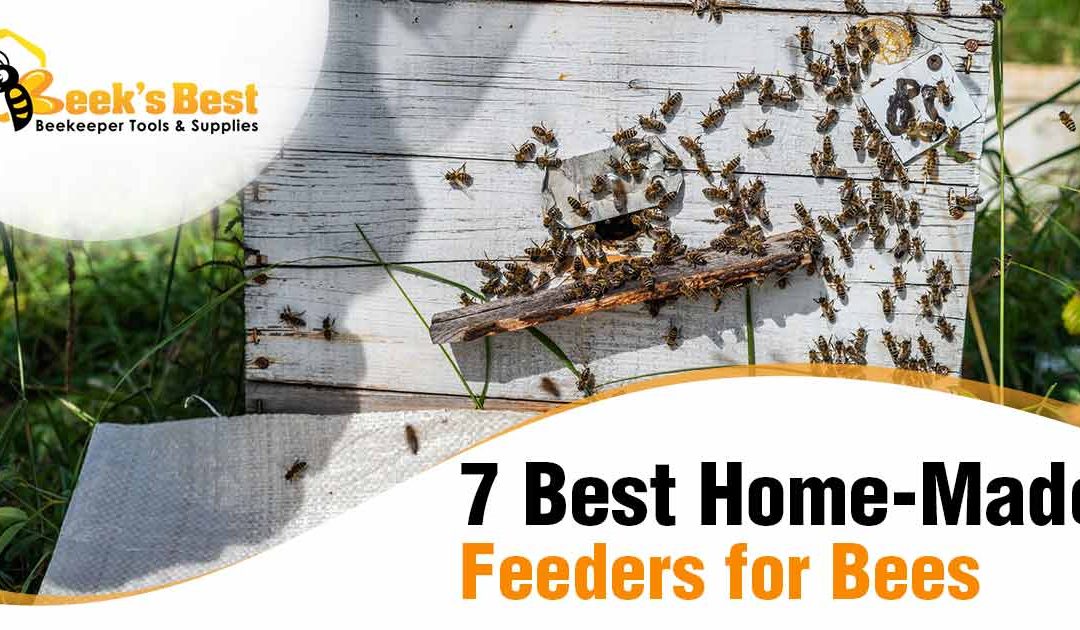Colonies of bees are self-sufficient when in nature. On top of that, bees have been surviving and thriving for centuries with no need from people. It’s a fact, once bees construct their hive and build their colony they can maintain and manage themselves efficiently. However, just like all nature’s creatures, there are times when bees need help. At times homemade feeders for bees are needed. This is when bees need additional food because of weather or other factors.
Having a homemade feeder requires some necessary equipment in order to build it, but Beek’s Best has all the equipment and beekeeping tools and supplies you’ll need to get started. In this article, we talk about the 7 homemade feeders for bees.
Why Would Bees Need Help with Food?
Though bees are completely capable of carrying out their colony with no human contact, there are special scenarios when having help makes it much easier on the bees to survive and thrive. Homemade feeders for bees give the bees this opportunity. The obvious reason for having a feeder is when your bees are running low on reserves.
When the seasons change and become cold the flowers that offer the pollen bees need to make honey become scarce, often times non-existent. If the bees have not created enough in honey reserves to get them through the winter months (or if their honey has been over-harvested), having a feeder will keep your bees from starving to death.
Colony establishment is also another reason for feeding bees.
It’s important to note, that bee feeders are only left for bees to offer a helping hand. They are not intended to be made available to bees all season. Bees rely on their instinct to work and create honey through a natural process. With that said, food shortages and starvation are common concerns beekeepers have.
After all, it doesn’t matter if it’s winter or summer if bees can starve if they’re not making enough honey to sustain the colony. It’s up to you to observe your hive and make the proper adjustments to help the bees.
Types of Homemade Bee Feeders
There are so many varieties of homemade bee feeders you can use. That means you want to pay attention to the variables and decide what makes a good feeder for you. Keep in mind however any choice you make will provide your bees food.
Providing food to your bees is one thing, but what you also want to consider is the robbing of your bee food and drowning of your bees.
These are things you want to consider when deciding on what type of feed to make and use. Unfortunately, there are some feeders that prompt robbing over others and feeders that enhance the ability to drown bees in the syrup they eat.
Bucket Feeder
This is a feeder that is made with a bucket and is one of the simplest ways to feed your bees. The pros are it’s very easy and simple to make. The con is your feeding every insect with the ability to fly.
Baggie Feeder
This is a simple zip lock baggie that is filled with bee feed (usually sugar water or syrup). This can easily be placed on top of the beehive box. You place small incisions in the top of the bag so bees can withdraw the syrup.
Boardman Feeder
Placed at the entryway of the beehive, this bee feeder holds a jar that is inverted. For example, a mason jar. These types of feeders promote robbing, but luckily, they are easy to observe.
Frame Feeder
Another easy to make a homemade feeder for bees is the frame feeder. Created with simple supplies using wood or plastic. These can also be called division board feeders. By using this kind of feeder, you can place it directly inside the hive.
Miller Feeder
There are many different variations of this type of feeder. The feeder goes at the top of the hive and is bigger in size. They hold more syrup than most other homemade feeders. Some suggest they are not good for winter months. For more information call Beeks Best at (866) 712-3357. We can answer all your questions.
Inverted Container
Here you have yet another easy DIY homemade bee feeder. This feed allows you to easily feed your bees with a jar, pale or other types of simple containers. The container is then turned upside down which then holds syrup in the bottom using air-pressure. Makes sure to take your time on the setup. They leak if not done properly.
Open Feeders
This is very similar to the bucket feeder; you just can make it out of any container. You want to add floats to the container, so your bees don’t drown. It’s best to have this feeder out of the hive. When you have these types of feeders it can benefit you when you have more than one hive, allowing bees to share. However, this does promote robbing of food, if other colonies are nearby.
In Summary
The homemade feeders for bees can be made with regular supplies that can be gathered from Beek’s Best your trusted and knowledgeable beekeeping supplies and tools provider. Learning the 7 best home feeders for bees has equipped you with the knowledge to go out and start building with confidence.


Recent Comments